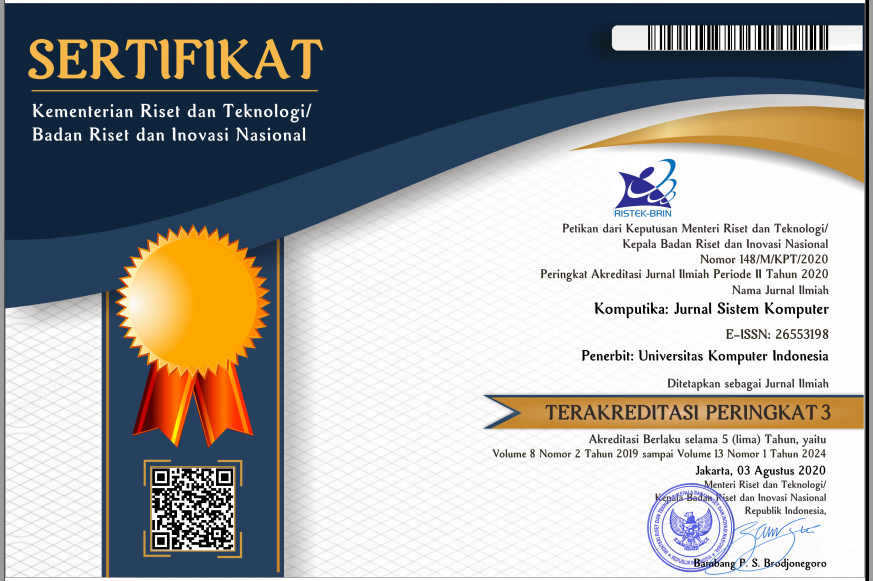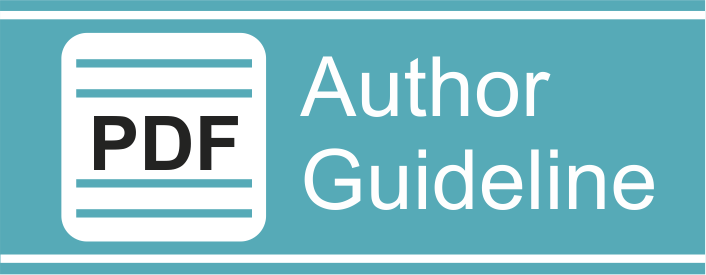Klasifikasi Pemenuhan Pilar Sanitasi Puskesmas Menggunakan Metode Naive Bayes
DOI:
https://doi.org/10.34010/komputika.v12i2.10336Abstract
Sanitation is an attempt to maintain the cleanliness and condition of the surrounding environment. In fulfilling the sanitation pillar in each region, of course we also need the role of health agencies to trigger and provide education. In the village where the scope of the Bontomangape Health Center is located, it is known that the fulfillment of the sanitation pillar is still uneven. Based on this, the author intends to classify the fulfillment of the sanitation pillars of the puskesmas using the Naive Bayes method so that the results of this classification can be used as a benchmark for villages that need to be prioritized by sanitation workers. The classification results obtained were 55 implemented and 20 not implemented for Bontomangape village, 70 implemented and 5 not implemented for Campagaya village, 60 implemented and 15 not implemented for Kalenna village, 45 implemented and 30 not implemented for Parambambe village, 52 implemented and 23 not implemented implemented for Parangmata village, 64 implemented and 11 not implemented for Parasangangberu village, and 57 implemented and 18 implemented for Pattinoang village. The classification results obtained an average accuracy value of 95,81%, a precision value of 94,78% and a recall value of 100%.
Keywords – Sanitation; Health; Puskesmas; Classification; Naive Bayes
References
S. Manton, M. Kanan, H. Herawati, F. S. Lanyumba, and S. N. Sakati, “Gambaran Pencapaian Lima Pilar Sanitasi Total Berbasis Masyarakat di Desa Lokotoy Kabupaten Banggai Laut,” Jurnal Kesmas Untika Luwuk : Public Health Journal, vol. 12, no. 2, 2021, doi: 10.51888/phj.v12i2.67.
I. Maliga, R. Rafi’ah, H. Hasifah, and N. A. Sholihah, “Penyuluhan Sanitasi Total Berbasis Masyarakat sebagai Upaya Pencegahan Penyakit Diare di Dusun Batu Bangka Kecamatan Moyo Hilir Kabupaten Sumbawa,” Jurnal Abdidas, vol. 3, no. 1, pp. 1–9, Feb. 2022, doi: 10.31004/abdidas.v3i1.519.
R. Hasibuan, M. Nanda, and R. Artikel, “Pemicuan Sanitasi Total Berbasis Masyarakat (STBM) Pilar BABS di Kota Sibolga,” Jurnal Pengabdian Kesehatan Masyarakat, vol. 1, no. 1, pp. 1–7, 2021.
A. M. Fahham, “Sanitasi dan Dampaknya bagi Kesehatan: Studi dari Pesantren,” Aspirasi: Jurnal Masalah-masalah Sosial, vol. 10, no. 1, 2019, doi: 10.46807/aspirasi.v10i1.1230.
W. Wulandari, D. A. Kartikasari, and L. P. Ratri, “Peran Petugas Kesehatan Terhadap Sanitasi Rumah di Kelurahan Semanggi Kota Surakarta,” Jurnal Kesehatan, vol. 12, no. 1, 2019, doi: 10.23917/jk.v12i1.8939.
N. Widiastuti, A. Hermawan, and D. Avianto, “Komparasi Algoritma Klasifikasi Data Mining Untuk Prediksi Minat Pencari Kerja,” Jurnal Teknoinfo, vol. 17, no. 1, pp. 1–9, 2023.
I. Loelianto, Moh. S. S. Thayf, and H. Angriani, “Implementasi Teori Naive Bayes Dalam Klasifikasi Calon Mahasiswa Baru Stmik Kharisma Makassar,” Jurnal Science And Information Technology (SINTECH), vol. 3, no. 2, pp. 1–8, 2020.
V. Regista, A. Fitria, and M. A. Kadir, “Gambaran Pelaksanaan 5 Pilar Sanitasi Total Berbasis Masyarakat di Kelurahan Kasturian Kota Ternate,” Svasta Harena: Jurnal Ilmiah Gizi, vol. 1, no. 2, 2021, doi: 10.33860/shjig.v2i1.478.
A. Zainal Macfud, A. Pandu Kusuma, and W. Dwi Puspitasari, “Analisis Algoritma Naive Bayes Classifier (NBC) Pada Klasifikasi Tingkat Minat Barang Di Toko Violet Cell,” Jurnal Mahasiswa Teknik Informatika (JATI), vol. 7, no. 1, pp. 1–8, 2023.
M. S. Syarah, M. Wati, and N. Puspitasari, “Klasifikasi Penderita ISPA Menggunakan Metode Naive Bayes Classifier,” Innovation in Research of Informatics (INNOVATICS), vol. 4, no. 1, pp. 1–8, 2022.
H. F. Putro, R. T. Vulandari, and W. L. Y. Saptomo, “Penerapan Metode Naive Bayes Untuk Klasifikasi Pelanggan,” Jurnal Teknologi Informasi dan Komunikasi (TIKomSiN), vol. 8, no. 2, Oct. 2020, doi: 10.30646/tikomsin.v8i2.500.
E. Fitriani, A. Saepudin, D. Ardiansyah, and R. Aryanti, “Implementasi Metode Naive Bayes Dalam Penyeleksian Karyawan Untuk Penempatan Bagian Pemasaran,” Jurnal Teknik Komputer AMIK BSI, vol. 8, no. 2, pp. 1–7, 2022, doi: 10.31294/jtk.v4i2.
Apif Supriadi and Fatmasari, “Implementasi Metode Klasifikasi Naive Bayes Pada Sistem Analisis Opini Pengguna Twitter Berbasis Web,” Jurnal Sistem Informasi, vol. 10, no. 1, pp. 1–9, 2021, doi: 10.51998/jsi.v10i1.356.
L. Syafie, F. Umar, A. Mude, H. Darwis, Herman, and Harlinda, “Missing Data Handling Using The Naive Bayes Logarithm (NBL) Formula,” IEEE Xplore, pp. 1–4, 2018.
Herman et al., “Comparison of Artificial Neural Network and Gaussian Naive Bayes in Recognition of Hand-Writing Number,” IEEE Xplore, pp. 1–4, 2018.
T. Imandasari, E. Irawan, A. P. Windarto, and A. Wanto, “Algoritma Naive Bayes Dalam Klasifikasi Lokasi Pembangunan Sumber Air,” Prosiding Seminar Nasional Riset Information Science (SENARIS), vol. 1, pp. 1–12, 2019, doi: 10.30645/senaris.v1i0.81.
I. Widhi Saputro and B. Wulan Sari, “Uji Performa Algoritma Naive Bayes untuk Prediksi Masa Studi Mahasiswa,” Citec Journal, vol. 6, no. 1, 2019.
D. Utami and P. Aisyiyah Rakhma Devi, “Klasifikasi Kelayakan Penerima Bantuan Program Keluarga Harapan (PKH) Menggunakan Metode Weighted Naive Bayes Dengan Laplace Smoothing,” JIPI (Jurnal Ilmiah Penelitian dan Pembelajaran Informatika), vol. 7, no. 4, pp. 1–12, 2022.



















